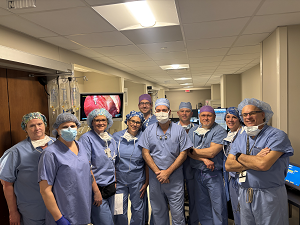Spring Training Alert: Core, Hip/Groin Injuries Prominent among Pitchers
DETROIT – With baseball’s spring training in full bloom, a study by Henry Ford Hospital highlights a set of injuries prominent among pitchers.
The study, published in the February edition of the Journal of Arthroscopic and Related Surgery, found that core and hip/groin injuries in Major League Baseball pitchers:
- Account for 21 percent of all pitching injuries that required time on the disabled list.
- Are associated with a high risk of reinjury.
Pitching workload, however, appeared to have little or no effect on sustaining an injury. A core injury was defined as a back spasm, stiffness or strain. Hip/groin injuries were a groin strain or hip inflammation or impingement, in which there is abnormal contact between the ball and socket of the hip joint.
 Eric Makhni, M.D., a Henry Ford sports medicine orthopedic surgeon and the study’s senior author, says core and hip/groin injuries, while largely understudied among professional pitchers, underscore the complex and constant interplay of the body’s mechanics and pitching motion.
Eric Makhni, M.D., a Henry Ford sports medicine orthopedic surgeon and the study’s senior author, says core and hip/groin injuries, while largely understudied among professional pitchers, underscore the complex and constant interplay of the body’s mechanics and pitching motion.
“Not only are these injuries becoming more prevalent among professional baseball pitchers, but we are also seeing a relatively high rate of reinjury as well. Pitchers with these injuries require an extra 10 days on the disabled list when compared with position players,” Dr. Makhni says.
For the retrospective study, researchers sought to examine the frequency of core and hip/groin injuries in MLB pitchers and its impact on performance. The team collected data of 330 pitchers who were placed on the disabled list for 454 injuries, collectively, for the 2014 and 2015 seasons. The data was then compared for the core and hip/groin injury groups against all other injuries. Key findings:
- Pitchers spent an average of 47 days on the disabled list with a core injury, compared to 38 days for a hip/groin injury.
- At least 73 percent of pitchers returned to pitch in the same season regardless of injury type.
- The risk for returning to the disabled list for a reinjury was high: 46 percent for a core injury and 56 percent for a hip/groin injury.
- Pitching workload was not associated with a core or hip/groin injury.
Researchers also found that the amount of pitching does not appear to increase the risk for injury for core and hip/groin injuries. Pitchers with a core or hip/groin injury saw a slight dip in fastball velocity. A deviation in pitcher statistics from career averages may signal an underlying injury that requires further study.
The study was funded by Henry Ford Hospital.
###
MEDIA CONTACT:
David Olejarz
David.Olejarz@hfhs.org
313.874.4094
.svg?iar=0&hash=F6049510E33E4E6D8196C26CCC0A64A4)

/hfh-logo-main--white.svg?iar=0&hash=ED491CBFADFB7670FAE94559C98D7798)








